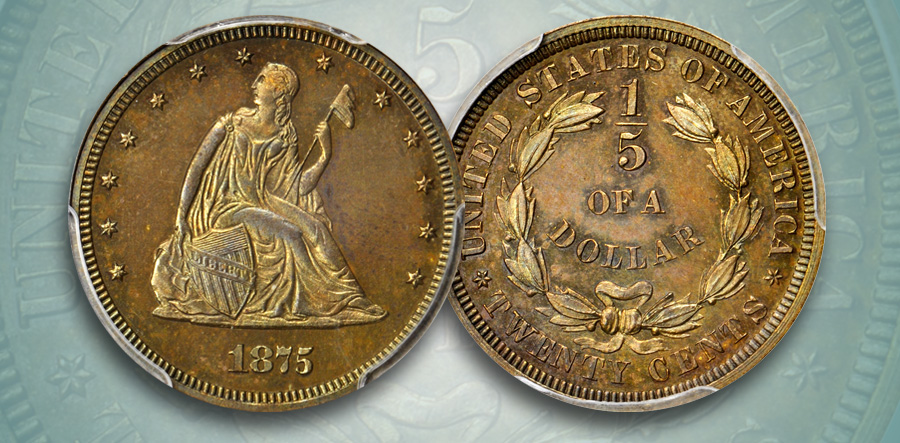
Among the featured highlights in our November 2016
Collectors Choice Online Auction is a gorgeous example of the 1875 pattern
twenty-cent piece designated Judd-1408. Offered as lot 90610, this piece,
certified Proof-65 BN by PCGS, carries a Rarity-7 rating and ranks among the
finest known of the issue.
This experimental twenty-cent issue represents a
significant milestone in the overall timeline of the denomination as it
pertains to the US Mint. The double dime was first proposed as a concept by
Thomas Jefferson as an equivalent to one fifth of a Spanish milled dollar,
which was a prevalent increment of commerce in 18th century America.
In a report to Congress on May 13, 1785, a grand committee of representatives
from each of the thirteen colonies rejected Jefferson’s suggestion of a
twenty-cent denomination in favor of the quarter dollar, choosing instead to
emulate the more common Spanish double reale and English shilling which
circulated at a value of twenty five cents.
Proposals for a twenty-cent piece would be
reintroduced to congress several times over the next century, failing to gain
approval in both 1806 and 1850. It wasn’t until the after Mint Act of February
1873 upset the equilibrium of the nation’s coinage that suggestions of the
denomination once again reappeared. This act eliminated the production of
silver three-cent pieces, half dimes, and silver dollars, spawning both
practical and political concerns that Senator John Percival Jones of Nevada
worked aggressively to mediate. Of the
more practical concerns, Jones argued, was the shortage of minor coins used to
make change throughout the West. The most propagated scenario involved a
consumer wishing to purchase an item valued at ten cents, but only having a
quarter to pay with. The merchant, also tragically lacking small coins, would
only be able to compensate the patron with ten cents in change, shorting them
five cents. These exploitive transactions were epidemic throughout the Western
US, as per Senator Jones, and a twenty-cent coin was necessary to remedy the
situation, he argued.
Less lauded though perhaps more encouraging was the
threat to the silver mining industry that the reduction in coin production
represented. The U.S. Mint was, at the time, the largest purchaser of silver in
the world, and domestic mine owners were very concerned over reduced demand and
lower prices. However, despite the seemingly persuasive nature of these concerns,
Senator Jones persistently campaigned the “short-change crisis” as his primary
argument for the twenty-cent piece, as lobbying too overtly for the mine owners
might reveal the fact that he himself
was a silver mine owner with a personal interest in the success of the proposed
coin. While the legitimacy of the Senator’s claims has never been fully validated,
his arguments were convincing enough and the twenty-cent piece was approved as
part of the Act of March 3, 1875, nearly a century after Jefferson first
suggested the denomination.
Even prior to this official sanctioning, the Mint had begun
trialing different designs for the pending double dime in 1874. Mint Director Henry
R. Linderman wrote to Superintendent James Pollock on April 20 of said year
with his own suggestions for a pattern to be executed, and examples were on
hand by the end of the summer. Over the course of the following year, a total
of six distinct design combinations would be evaluated, chiefly with the goal
of finding ways to differentiate the new coin from the inconveniently similar
quarter. A few designs chose to place the denomination 20 CENTS in large
characters at the central reverse in order to avoid confusion. In an ever
bolder suggestion, one reverse featured the denomination represented by a
fraction, reading 1/5 OF A DOLLAR, filling up the upper and central fields.
When paired with an obverse similar to the adopted design and struck in copper,
this proposed pairing is classified under the Judd-1408 attribution and less
than a dozen are thought to remain today.
The present offering of this desirable rarity is graced
by a lovely patina of bronze and apricot hues, accented by lavender tones in
select areas. A brilliant luster
blankets the devices, subtly contrasting the glassy reflectivity that shimmers
throughout the fields on each side. A minor weakness is apparent to the obverse
elements, though the reverse is pleasantly bold. Smooth and untroubled by
blemishes of any worth, the surfaces uphold true Gem quality and will satisfy
even the most discerning pattern enthusiast.
This Rarity-7 jewel is featured in lot 90610 of our
November 2016 Collectors Choice Online Auction, which is available now for
viewing and pre-bidding at Stacksbowers.com. The sale will begin live bidding
at 10am PST on Wednesday, November 16 so make sure to mark your calendar and
stop by to join in on the excitement! To consign your coins to a future event
contact us today at 1-800-458-4646 to speak with a Consignment Director and see
what Stack’s Bowers Galleries can do for you.





